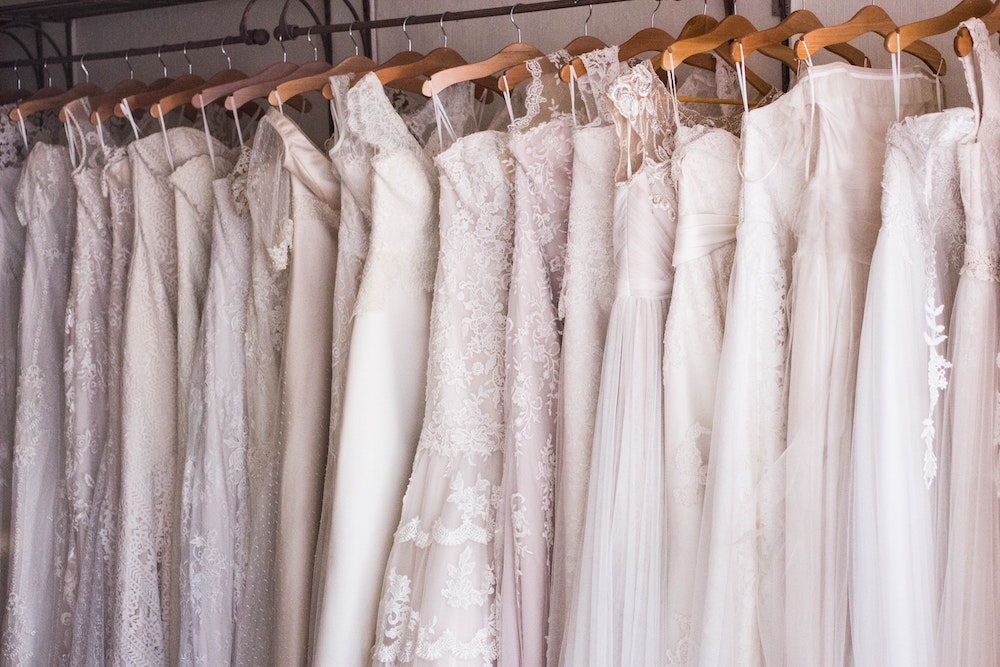
One year my mother decided to up her game. She had discovered a nearby convent had a sewing ministry. She asked if she could donate her wedding dress to be used as fabric for an Easter chasuble for her brother. (Unsplash/Charisse Kenion)
Tucked away high on a shelf, out of mind and out of arm's reach, my wedding dress has maintained its clandestine existence for more than 30 years.
It made its one and only debut on a cold and dark December night. I had anguished over the process of finding it. I was never much for shopping and the idea of being turned on a revolving pedestal, while poked and perused by a gaggle of shopkeepers, made me feel both queasy and embarrassed. The price tag only heightened my discomfort. Although my father was happy to foot the bill, it felt like an inordinately expensive and frivolous purchase. Bridezilla I was not.
Fortunately, this rite of passage was short-lived. With my mother leaning over my shoulder, I gently tugged at the hangers on a rack of gowns at our first stop. About halfway through the collection I discovered "the dress." Fashioned from a creamy ivory satin, it was both simple and elegant. A floor-length design with long sleeves, it was the perfect option for a winter wedding. The bodice had a spray of delicate pearl beading. The sleeves sported eight silk buttons at the wrist. The modest scoop neckline was matched by an equally conservative train. I had found my needle in the bridal salon haystack. Believe me when I say, it was a relief for all involved.
After the wedding my mother offered to have the gown professionally cleaned and stored. I wasn't sure what else to do, so I acquiesced. Upon its return from a specialty cleaner, my mother placed the sealed box in the closet of my childhood bedroom. And there it remained for 25 years.
When my mother died, my brother and I sifted through my parents' belongings. It was a small 1950s ranch house, replete with its original linoleum, laminate red countertops and a rotary phone that still hung from the kitchen wall.
Despite its diminutive size, every nook and cranny of the house was filled to the brim. After a few Saturday morning yard sales and a hefty donation to Goodwill, all that remained were the pieces that tugged at our hearts: my father's WWII uniform, the knife my mother used to make our peanut butter and jelly sandwiches, and my wedding gown.
Advertisement
On the day before the house was to be sold, I pulled into the driveway one final time. Wandering down the hall to my former bedroom, I pressed my shoulder blades against the yellowed wallpaper and slowly sank to the ground. I'm not sure how long I sat in that empty room, but eventually I got up and turned the knob on the closet door. The box was still there, last touched by the person who had placed it there. I ran my fingers along the cardboard, searching for some remnant of my mother. Finding none, I slipped it off the shelf for good.
For nearly a decade, I have stored the box in a closet of my own. Only a recent move pushed me to rethink what to do about this perennial conundrum. With storage space now at a premium, it felt like the time had finally come to let go.
But who would say yes to the dress? Consignment shops seemed too commercial an option for something as sentimental and sacred as a wedding gown. Similarly, I couldn't imagine leaving the box at the local Goodwill trailer. Without a daughter of my own to lobby, I found myself, once again, at a dead end.
The answer would come, strangely enough, from my mother.
She was raised in a devout Irish Catholic family: One of her older brothers joined the Jesuits. At his ordination he took a vow of poverty, and as such, any gifts he received were required to be shared with his community. In an effort to find something that could be given to him exclusively, his loved ones often bought him clothes for Christmas and his birthday.
One year my mother decided to up her game. She had discovered a nearby convent had a sewing ministry. She asked if she could donate her wedding dress to be used as fabric for an Easter chasuble for her brother. The nuns agreed and my mother, not known for sentimentality, dutifully dropped off her gown. I was reminded of this story while recently going through a box of her things. As a minister myself, I found this idea particularly appealing. And after a number of phone calls, I too discovered a nearby convent doing such work.

Boston Carmel sisters' Roxbury, Massachusetts, monastery entrance, when the author visited to donate her wedding dress (Anne Gardner)
In the middle of an otherwise nondescript residential street, the red-brick edifice of Boston Carmel peeks out from behind its protective wall. For a community originally founded in 1890, the convent and chapel were built on the grounds of the Morrill Estate. It stands today as the oldest surviving Carmelite monastery in the country.
Today the Carmel houses eight cloistered nuns. A wrought-iron arch with the words "Pray Always" hovers over the main entry of their three-acre compound. They are a contemplative order, so prayer is the mainstay of the Carmelite tradition. Something they proved by answering mine.
In the end, it was remarkably easy to hand over my wedding gown to Sister Bernadette, the convent's resident seamstress. But perhaps I won't have to say goodbye forever. "Do with it what you will," I told her. "But might you save a bit of fabric and make a stole for me?"







